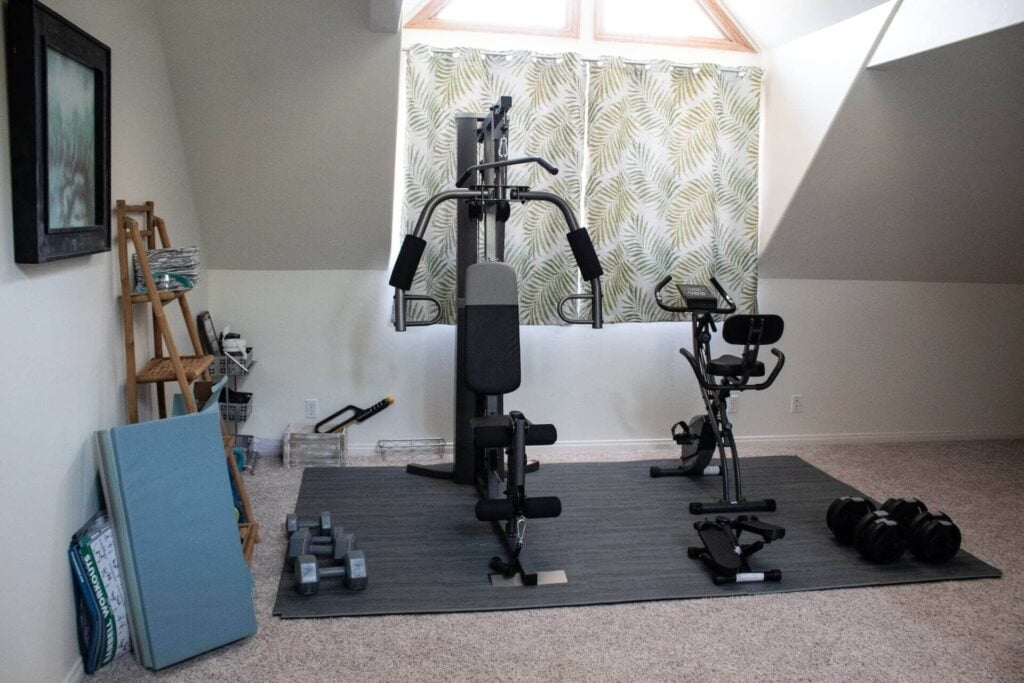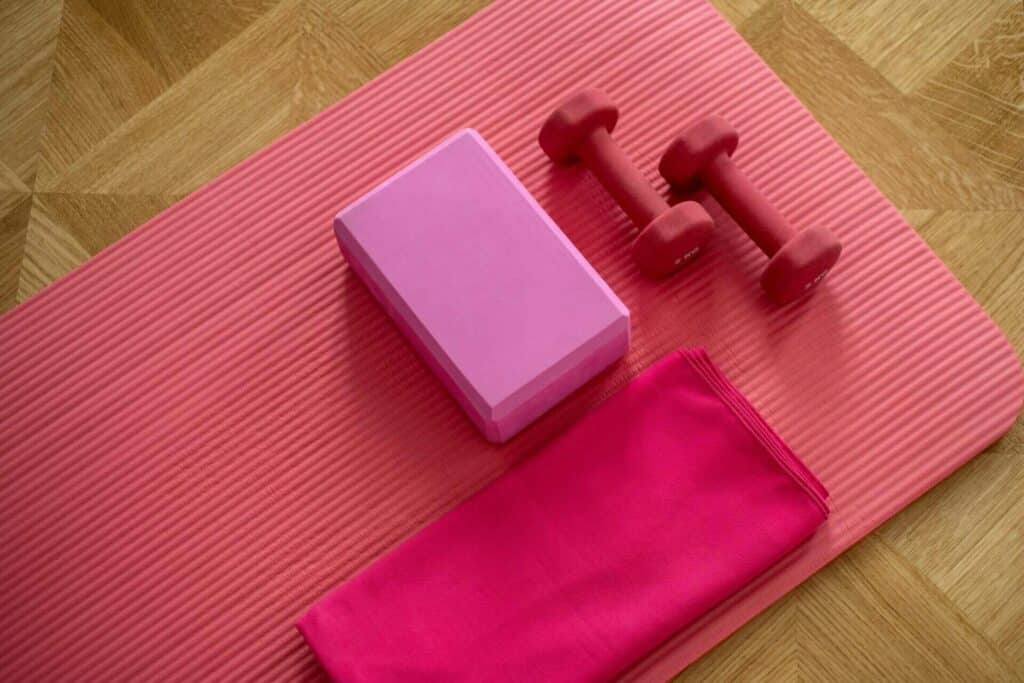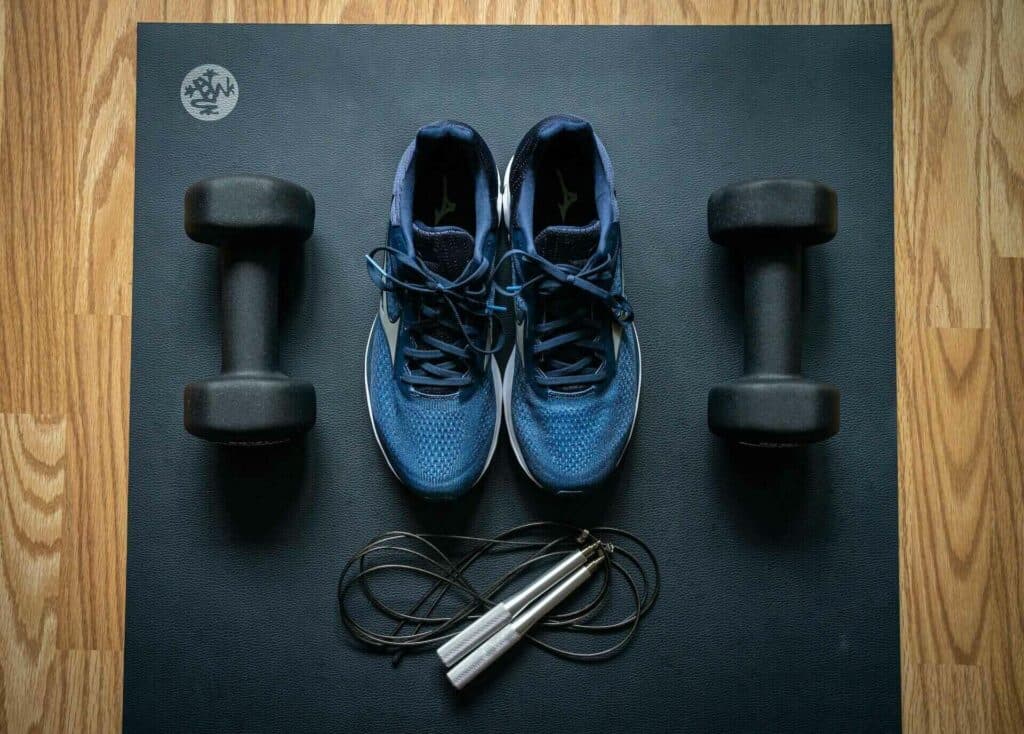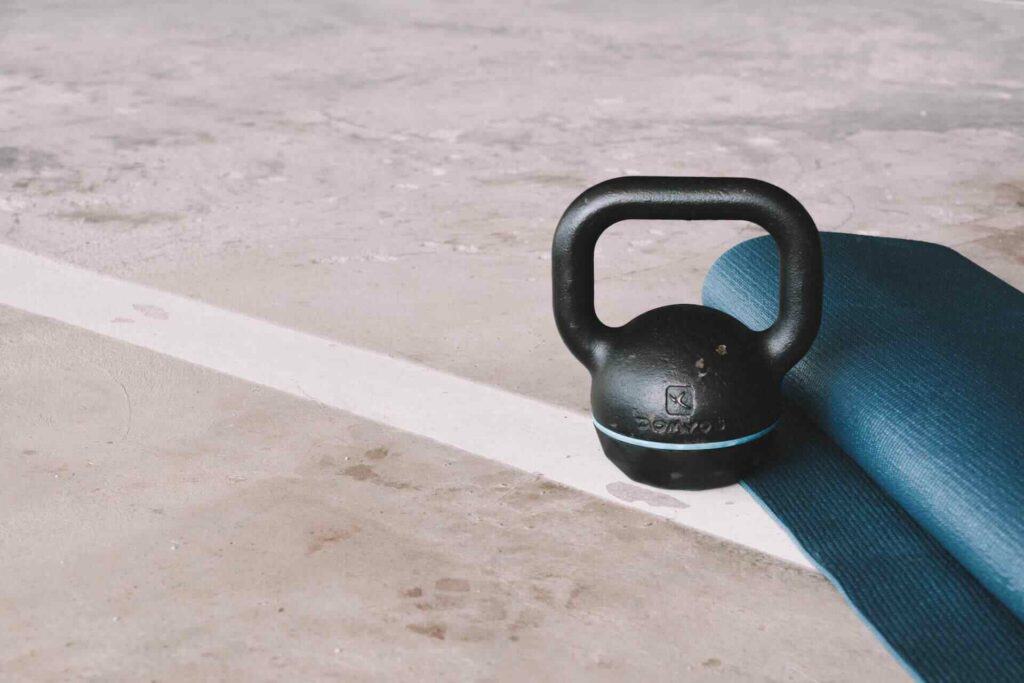Don’t Have Enough Time? Here Are The Key Points
- Planning and Budgeting: Assess space and budget for the gym, considering the type of flooring and available room for exercise.
- Selecting Equipment: Choose compact and versatile equipment like resistance bands, pull-up bars, and suspension trainers tailored to fitness goals.
- Organizing Space: Utilize storage solutions to keep the gym organized, and consider multi-purpose equipment to maximize space efficiency.
- Creating a Workout Routine: Start with basic exercises like push-ups and squats, then progressively increase difficulty. Track progress to stay motivated.
- Motivational Environment: Personalize the space with inspirational elements to maintain motivation and enjoyment.
With escalating gym membership fees, constraints from gym equipment like weights, and the lingering effects of COVID-19, maintaining health and wellness at home has become a crucial aspect of our everyday lives.
This post offers a step-by-step guide to establishing an efficient and affordable bodyweight gym in your living room!
No more jostling for space or waiting for machines; by harnessing the weight of your own body, you can sculpt, tone, and build muscle.
It offers the flexibility to do everything from a simple push-up to a perfect lunge without breaking the bank. Plus, it allows people to read on to uncover a new workout routine with limitless potential – accessible anytime, anywhere!
Setting up a home bodyweight gym requires careful planning and consideration. You’ll have to balance the space and budget, then select key equipment such as a pull-up bar, dip station, suspension trainer, resistance bands, and an adjustable bar.
Also, consider incorporating tools like kettlebells for added variety. Optimize the space with storage solutions and make it a place where things are easily accessible.
Our comprehensive guide covers all the steps to help you set up your home bodyweight gym successfully.
JUMP TO
Preparations for Creating a Home Bodyweight Gym

If you embark on the exciting journey of creating your home bodyweight gym, you must make a few important preparations.
Building a successful home gym routine can be challenging due to busy schedules, limited space, and competing priorities.
However, you can bring your fitness goals to life in your home with careful planning, a clear vision, and adherence to a routine that includes push-ups, lunges, and kettlebell swings.
Assessing your space and budget is crucial before purchasing equipment or designing your workout routine.
Some questions to consider during this initial phase include what your budget allows for purchasing things like pull-up bars, kettlebells, or resistance bands.
- How much space do you have available for your home gym?
- What type of flooring do you have in that space? Is it suitable for bodyweight exercises?
- How much are you willing to invest in setting up your home gym?
Evaluating these factors will help guide your decision-making process and prevent any surprises along the way.
It can make everything go smoother and ensure you’re setting up a gym that suits your health and fitness goals.
- Creating a successful home bodyweight gym requires careful planning and consideration of available space, budget, and personal goals. These factors will help make informed decisions and avoid unexpected challenges during the setup process.
Assessing Your Space and Budget
Assessing your space and budget is essential in creating an affordable home bodyweight gym. The available space will determine the type and quantity of equipment you can accommodate.
Consider measuring the dimensions of the area dedicated to your gym, taking note of any potential limitations such as low ceilings, obstructions, or lack of room for performing exercises like lunges and kettlebell swings.
Next, consider your budget. Determine how much you’re willing to invest in building your home gym. Remember that affordability is key, and you don’t necessarily need an elaborate setup to do bodyweight exercises.
Simple things like a good-quality push-up bar can make a world of difference.
For example, suppose you’re working with limited space and a tight budget. In that case, versatile bodyweight equipment options, such as pull-up bars, resistance bands, and suspension trainers, offer a wide range of exercise possibilities without breaking the bank.
Even items like kettlebells can be cost-effective, offering versatility for your workout routine.
By carefully assessing your space availability and budget constraints, you can strategically plan for your home bodyweight gym and make informed decisions about the equipment that best suits your needs.
Remember, the goal is to create an environment that supports your fitness journey while being practical and cost-effective.
- According to the American Council on Exercise, when engaging in bodyweight exercises such as kettlebell workouts for 20 minutes daily, the average calorie burn was 272, not counting additional calories due to the substantial anaerobic effort.
- Market research from The NPD Group shows that home gym equipment sales rose nearly 130% during the first few months of the COVID-19 lockdowns.
- A TD Ameritrade survey conducted in 2020 found that almost 59% of Americans planned to cancel their gym membership due to discovering successful at-home workout routines, which include bodyweight exercises.
Selecting the Right Bodyweight Equipment

Selecting the right equipment is crucial when creating an affordable home bodyweight gym. The beauty of bodyweight exercises is that they require minimal equipment, making them accessible to almost anyone.
Here are a few key factors to consider when choosing bodyweight equipment:
- Space: Evaluate the available space in your home, as different equipment options require varying amounts of room.
Compact and versatile equipment like resistance bands or suspension trainers can be ideal for small spaces.
If you have enough room to do a squat, that’s a good start – you can do almost anything with enough space to perform a full range of motion with your legs. - Fitness Goals: Consider your fitness goals and the type of exercises you plan to do. For example, investing in a pull-up bar or dip station would be beneficial if you focus on strength training. On the other hand, if cardio and agility are your main targets, jump ropes or agility ladders might be more suitable.
For beginners, it’s important to start with something manageable and gradually increase intensity and complexity over time. - Budget: Set a budget for your home gym and prioritize your purchases accordingly. Many bodyweight exercises can be done without equipment, but investing in a few key pieces can enhance your workouts.
Besides your bodyweight exercise regimen, a piece of cardio equipment or weights offers an excellent way to round out your routine. - Quality and Durability: Ensure that the equipment you choose is of good quality and built to last. Look for reputable brands with positive reviews to avoid disappointment down the line.
Don’t hesitate to ask for recommendations or read comments from other consumers who’ve used the equipment. - Versatility: Opt for equipment that offers versatility and allows for a wide range of exercise variations. This will ensure you can target different muscle groups and keep your workouts varied and engaging.
Remember, starting small with basic bodyweight exercises like push-ups, squats, planks, and lunges can be highly effective before adding additional equipment.
Now that we’ve discussed selecting the right bodyweight equipment for your home gym let’s explore some must-have equipment options for a well-rounded workout routine.
Must-Have Equipment for a Home Gym
Building an effective home gym doesn’t have to break the bank. You can create a versatile space for your bodyweight workouts by choosing a few key pieces of equipment. Here are some essential items to consider:
- Resistance Bands: These portable and affordable bands have various strengths and provide resistance for upper and lower body exercises. They are handy for targeting smaller muscle groups and adding intensity to your workout.
- Jump Rope: An excellent way to improve cardiovascular fitness, burn calories, and enhance coordination. It’s lightweight, compact, and suitable for all fitness levels.
- Yoga Mat: A comfortable surface for floor-based exercises and stretching routines. Look for a mat with a good grip to prevent slipping during intense workouts.
- Pull-Up Bar: Ideal for working the upper body, a pull-up bar can be easily installed in a doorway or mounted on a wall. It allows you to perform exercises like pull-ups, chin-ups, and hanging leg raises.
- Suspension Trainer: Another versatile option with straps anchored to a stable point. Suspension trainers offer countless exercise possibilities targeting various muscle groups while improving stability and core strength.
Remember that these equipment suggestions are just starting points and can be modified depending on your specific goals, preferences, and available space.
Organizing and Optimizing Your Home Gym

When creating an affordable home bodyweight gym, organizing and optimizing your space is key. Assessing the available space in your home is the first step in building a functional workout area.
Consider factors such as the type of flooring, room dimensions, and potential limitations on equipment placement. It’s never too late to start, so why not consider the addition of a home gym today.
By strategically organizing and sorting out your gym, creating an area in your home, or perhaps finding a place in your garage, you can maximize available space and craft an efficient and enjoyable workout environment.
One key benefit of doing so is the creation of a dedicated corner for strength training exercises such as bench presses and squat racks with barbells in place.
For instance, if you have limited space, consider utilizing vertical storage solutions to keep your equipment off the floor.
Adding wall-mounted hooks or shelves can create a place to hang resistance bands or store smaller items like exercise mats.
By using these smart storage solutions, you not only save space but also maintain an organized and clutter-free workout area.
Additionally, optimizing your home gym means making the most of multi-purpose equipment. Look for versatile options such as a bench press and adjustable bars or stations that offer various exercise possibilities.
This allows you to perform a range of bodyweight exercises without needing multiple pieces of equipment. Investing in multi-functional tools saves money and has the added benefit of freeing up valuable space.
Remember that creating an inviting and motivating environment is crucial for staying committed to your fitness routine.
Personalize the space with inspirational quotes, posters, or mirrors to enhance your workout experience. Consider incorporating natural light or vibrant colors to create an energetic ambiance that helps boost your motivation during workouts.
Now that you have organized and optimized your garage gym or another dedicated fitness place, let’s explore how using storage solutions and creating a motivating environment can further elevate your workout experience.
Using Storage Solutions and Creating a Motivating Environment
Efficient storage solutions play a significant role in maintaining order in your gym while ensuring quick access to equipment when needed.
Investing in storage racks or cabinets provides designated spaces for larger items like resistance bands, exercise balls, or barbells.
This keeps your equipment organized and protects it from damage, benefiting your training routine.
Consider using space-saving options such as wall-mounted racks or overhead storage units to take your storage to the next level.
These options can accommodate larger equipment like pull-up bars or dip stations, keeping them safely stowed away when not in use and creating additional floor space for exercises like bench presses and squats using barbells.
Creating a motivating environment is equally important for the success of your garage gym. Consider adding elements that energize and inspire you during your workout sessions.
Pump your favorite upbeat music or install a sound system to keep you engaged and motivated throughout your routine. Post motivational quotes or posters on the corner walls to remind yourself of your fitness goals.
Remember, your home gym is a personal space, so make it your own. Tailor it to your preferences and needs to ensure that every time you step into that place, you feel motivated and excited to work out.
Building Your Bodyweight Workout Routine

When building a successful bodyweight workout routine, there are a few essential steps to consider. First, set clear and achievable fitness goals.
This will help guide your exercise selection and progression. Whether you want to build strength with a barbell bench press, improve flexibility, or increase endurance, defining your goals is crucial.
Next, determine the exercises that align with your goals. For example, if your goal is to improve upper body strength, exercises like push-ups, pull-ups, and dips would be beneficial.
Alternatively, if you aim for strong legs and glutes, sort out a corner for a squat rack in your garage.
Consider compound movements (exercises that work for multiple muscle groups simultaneously) and isolation exercises (which target specific muscles).
For instance, using a barbell targets multiple muscle groups, enhancing the workout much more, whereas a doorway pull-up bar targets specific muscles on your arms and back.
Tom wants to incorporate bodyweight training into his routine to lose weight and increase overall fitness.
Lacking a dedicated workout space, he uses a section of his living room along with the prerequisites: a doorway pull-up bar, a barbell, and, of course, his own body weight.
He sets a goal of performing 3 sets of 10 push-ups, 10 squats, and 10 lunges each day for the first month.
Once you have identified the exercises and suitable locations in your home, such as the door frame, it’s important to increase difficulty gradually over time.
This ensures that your body continues to adapt, undergoes recovery, and you make continued progress towards your goals.
Start with variations or modifications of the exercises that suit your current fitness level and gradually work towards more challenging variations.
Additionally, proper form and technique should always be a priority. It’s better to perform fewer reps with proper form using the barbell or the doorway pull-up bar than rushing through exercises with poor form.
This reduces the risk of injury and maximizes the effectiveness of each exercise.
Lastly, remember to incorporate rest days into your routine. Rest is as crucial as exercise because it allows your muscles time to recover and grow stronger.
Overtraining can lead to fatigue, decreased performance, and even injuries.
Now, let’s explore the progressive increase in difficulty and tracking progress in your bodyweight workout routine within your workout space- the area around your door, living room, or elsewhere in your home.
Progressive Increase in Difficulty and Tracking Progress
To continue challenging your body and making progress, it’s important to gradually increase the difficulty of your exercises as your strength and fitness levels improve. This can be achieved in various ways.
One approach is to increase the number of repetitions. For example, if you initially did 10 push-ups, you can gradually work towards 15 or 20 reps per set.
Another way is to lengthen the duration of each exercise. If you were holding a plank for 30 seconds, aim to hold it for 45 seconds or even a minute.
Tracking your progress motivates and provides valuable insights into your growth and areas that require recovery or additional work.
Implementing a system to track your progress is essential. You can maintain a workout journal, use a mobile app, or even create a simple spreadsheet to record the details of each workout session.
Note the exercises performed, sets, reps, and any modifications or variations. This helps you visualize your progress over time and make adjustments when necessary.
Monitoring and celebrating small victories along the way can be highly motivating. It may be surpassing a previous rep record, increasing the difficulty level of an exercise, or achieving a specific fitness milestone you set for yourself.
Let’s return to Tom’s journey. After his first month of consistent bodyweight training, he can perform 3 sets of 12 push-ups with proper form without feeling as fatigued as before.
This tangible progress gives him confidence and furthers his fitness journey.
You can ensure continued growth and avoid plateaus by continuously assessing your progress and adapting your routine accordingly.
Building fitness takes time and consistency, so be patient with yourself. Tom has made significant progress since incorporating the doorway pull-up bar into his home workout routine and the dedicated recovery time.
His story serves as a reminder that fitness can be achieved even without a traditional gym space, just utilizing corners of your home and some simple equipment.
